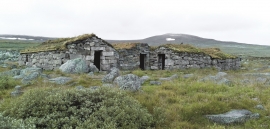Published: 08.11.2012 | Author: Nils Georg Brekke
Agastølen (A. B. Wilse, eigar Norsk Folkemuseum).
Whoever wanders the mountain plateau will form time to time hit upon old mountain summer farms, with solid old stone sheds, half sunk into the ground; a building tradition that has roots into prehistoric times. When we have been satiated with untouched Nature, it is somewhat comforting to come upon the old mountain chalets - they represent a type of human encroachment that we not only accept, but appreciate. They arouse a feeling of recognition and are a distinct witness to how people in the rural communities have made use of even the most remote resources.
Agastølen in Bjoreidalen is an old mountain summer farm; perhaps the origin stems from an old stone shed that was erected in connection with old cattle drovers. One of the old routes passed here, but only in the 1800s was this settlement expanded with many houses. In the second half of the 1800s, the place was sold to Knut Aga, and acquired the name Agastølen. He is probably the one who built the settlement as it appears today; a building with an annex and fireplace, another one without fireplace, a cheese-shed, a milking-shed, a churning-shed and a cowshed.
In order to use the outlying fields to their maximum potential, the farms in the fjord communities had several mountain farms, at various distances from the main farm. The nearest farms were spring and autumn farms. These were so close to the main farm that the milkmaid could come home with the milk. On the far-away farms, the summer pasture farms in the mountains, the milkmaids lived for 10-12 weeks in the summer. This is where they churned the butter and made cheese. The cheese making required a great amount of fuel, and many summer farms had to move as the forest was depleted. Winter fodder was also collected at the summer pasture. This activity, with cattle grazing, wood cutting and collecting of fodder, has had a great impact on the cultural landscape in the mountain.





